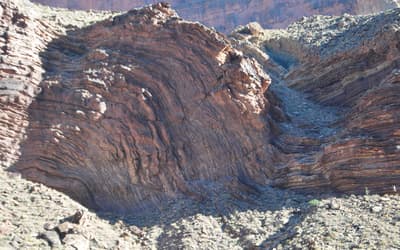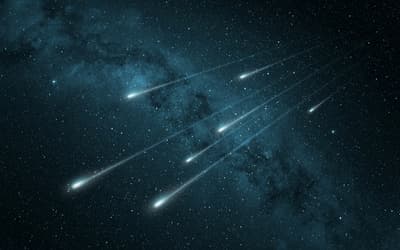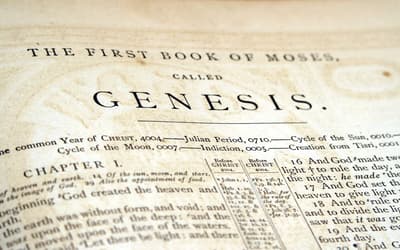Professional, peer-reviewed papers addressing the biblical and theological teaching on the age of the earth.

The Whitmore Helipad Fold, Western Grand Canyon, Arizona
Dr. Andrew A. Snelling • Feb. 28, 2024
The Bright Angel Formation beds easily responded to soft-sediment deformation to form the smooth bending in the Whitmore Helipad fold.

The Monument Fold, Central Grand Canyon, Arizona
Dr. Andrew A. Snelling • Aug. 9, 2023
Because the Tapeats Sandstone beds were still relatively unlithified and soft less than a year after rapid burial, they easily responded to soft-sediment deformation.

Using Stromatolites to Rethink the Precambrian-Cambrian Pre-Flood/Flood Boundary
Ken P Coulson • May 5, 2021
Many creationists are actively engaged in finding the Flood/post-Flood boundary, but most creationists consider the Precambrian-Cambrian contact more attractive.

Theistic Evolution: A Response to Wayne Grudem, Making the Same Errors He Opposes in Others
Dr. Terry Mortenson • Feb. 17, 2021
Grudem is making the same biblical and theological errors that theistic evolutionists make. To be biblically consistent, he must abandon his old-earth position.

The Grand Canyon, Monument to an Ancient Earth: The Deceptions Continue
Dr. Terry Mortenson • Dec. 2, 2020
The Grand Canyon, Monument to Ancient Earth? rejects the truth of Genesis regarding the Flood and the age of the earth.

Inerrancy and Biblical Authority: How and Why Old-Earth Inerrantists Are Unintentionally Undermining Inerrancy
Dr. Terry Mortenson • Sept. 16, 2020
The old-earth signers of the CSBInerrancy unintentionally violated their own principles of interpretation and unintentionally undermined the inerrancy and the authority of Scripture.

Effects of the Fall on the Physical Creation: A Biblical Analysis
Zachary Klein , et. al. • Aug. 12, 2020
To interpret the natural world through the lens of Scripture, one must have a correct understanding of the Fall and its effects on the physical creation.

How Scholars’ Perceptions of the Semantic Range of יוֹם Have Affected Their Discussions of the Age of the Universe: Part 3
John C. P. Smith • July 17, 2019
The study looks at delineations and definitions of יוֹם in Scripture, and in lexical and other sources.

How Scholars’ Perceptions of the Semantic Range of יוֹם Have Affected Their Discussions of the Age of the Universe: Part 2
John C. P. Smith • April 24, 2019
There is a considerable disconnection between lexicography regarding יוֹם and the formation of creation theology.

How Scholars’ Perceptions of the Semantic Range of יוֹם Have Affected Their Discussions of the Age of the Universe: Part 1
John C. P. Smith • March 13, 2019
There is a considerable disconnection between lexicography regarding יוֹם and the formation of creation theology.

Critical Analysis of Hugh Ross’ Progressive Day-Age Creationism Through the Framework of Young-Earth Creationism
David Mcgee • Feb. 13, 2019
The most important part of the debate between views on creationism is about the presuppositions of each group and their biblical hermeneutics.

Phenomenological Language and Semantic Naïveté
Kevin Short • June 28, 2017
Denis Lamoureux seeks to resolve perceived contradictions between science and Scripture by persuading that Scripture is not inerrant.

Scriptural Geology, Then and Now
Warren H. Johns • Nov. 30, 2016
The place of the biblical Flood in the geological record remains one of the most hotly debated issues among creationist geologists today.

The Nature of the Neo-Darwinian Evangelicals’ Criticism of Young-Earth Creationists
Jim Owen • Nov. 23, 2016
If we do not understand the dimensions of the war we are engaged in, we are already halfway to theological and historical oblivion.

Revisiting an Iconic Argument for Milankovitch Climate Forcing: Should the “Pacemaker of the Ice Ages” Paper Be Retracted? Part 3
Dr. Jake Hebert • Sept. 14, 2016
Despite its popularity, the Milankovitch hypothesis has many problems that are acknowledged even by secular scientists (Cronin 2010, 130–139).

Determination of the Radioisotope Decay Constants and Half-lives: Potassium-40 (40K)
Dr. Andrew A. Snelling • Aug. 3, 2016
Dr. Snelling documents the methodology and history of determining present decay constants and half-lives of parent radioisotopes used for dating methods.

Revisiting an Iconic Argument for Milankovitch Climate Forcing: Should the “Pacemaker of the Ice Ages” Paper Be Retracted? Part 2
Dr. Jake Hebert • May 25, 2016
Part I of this series presented a number of serious problems with the Pacemaker paper. It is necessary to also understand the Blackman-Tukey (B-T) method.

On the Origin of Eukaryotic Species’ Genotypic and Phenotypic Diversity
Dr. Nathaniel T. Jeanson , et. al. • April 20, 2016
This study shows that created heterozygosity, together with natural processes that are observable, is sufficient to account for species’ diversity.

New Method to Assess the Luminosity Function of Galaxies
Dr. Jason Lisle • March 30, 2016
We find that small variations in galaxy density as a function of redshift do exist, and are not due to the Malmquist bias.

Thoughts on the rāqîa‘ and a Possible Explanation for the Cosmic Microwave Background
Dr. Danny R. Faulkner • March 23, 2016
Dr. Danny Faulkner proposes that Genesis 1:1 is an introductory encapsulation that establishes a foundation for building a biblical model of astronomy.

Revisiting an Iconic Argument for Milankovitch Climate Forcing: Should the “Pacemaker of the Ice Ages” Paper Be Retracted? Part 1
Dr. Jake Hebert • March 9, 2016
This paper, the first in a series, demonstrates that much of the Hays et al. paper, as originally presented, is invalid.

Numerical Modeling of the Large-Scale Erosion, Sediment Transport, and Deposition Processes of the Genesis Flood
Dr. John Baumgardner • Feb. 24, 2016
Accounting for thick sediment sequences blanketing the surfaces of the continents is a paramount issue for understanding physical aspects of the Genesis Flood.

Challenging the BioLogos Claim that a Vitellogenin (Egg-Laying) Pseudogene Exists in the Human Genome
Jeffrey P. Tomkins • Oct. 21, 2015
Interestingly, BioLogos is probably the only evolutionary group that puts such a high level of focus on this hypothesis as key evidence for evolution.

Documented Anomaly in Recent Versions of the BLASTN Algorithm and a Complete Reanalysis of Chimpanzee and Human Genome-Wide DNA Similarity Using Nucmer and LASTZ
Jeffrey P. Tomkins • Oct. 7, 2015
Past evolutionary research in comparative DNA analysis between chimps and humans has employed a great deal of preferential and selective data analysis.

The Lost World of Adam and Eve: A Response
Steve Ham • July 29, 2015
This paper contends that Walton has given a magisterial authority to the ANE mythic texts in order to interpret the Genesis accounts.

Determination of the Radioisotope Decay Constants and Half-Lives: Samarium-147 (147Sm)
Dr. Andrew A. Snelling • June 10, 2015
Over the last 80 years numerous determinations have been made of the 147Sm half-life.

A Review of Hugh Ross’ Latest Book, Navigating Genesis
Dr. Danny R. Faulkner • April 15, 2015
While many Christians support Ross’ broad conclusions, few would agree with the details of Dr. Ross’ argument.

Physical Difficulties with Hugh Ross’ Local Flood Model
Dr. Danny R. Faulkner • April 15, 2015
There are at least three problems with Hugh Ross’ local flood model which render it physically impossible. This is in addition to numerous biblical issues.

A Reply to Bruce Gordon’s Biblical Critique of Young-Earth Creationism
Ashby L. Camp • Jan. 28, 2015
Dr. Gordon recently published a critique of the claims of young-earth creation. This reply is to the biblical criticisms in his paper.

Old Earth Theology: A Factor that Explains Inconsistent Belief of Inerrancy Among Florida Southern Baptists
David Mcgee • Oct. 1, 2014
A major shift in thinking seems to be occurring in contemporary evangelical thinking.

Circular Reasoning in the Dating of Deep Seafloor Sediments and Ice Cores: The Orbital Tuning Method
Dr. Jake Hebert • Aug. 27, 2014
The different dating systems are calibrated to one another: dates assigned to the seafloor sediments are used to date the ice cores, and vice versa.

Thoughts on the Goodness of Creation: In What Sense was Creation “Perfect”?
Lee Anderson, Jr. • Nov. 13, 2013
This paper contends that there is no real biblical evidence to suggest that the second law was inoperable prior to the curse.

Jesus, Scripture and Error: An Implication of Theistic Evolution
Simon Turpin • Oct. 30, 2013
The very teachings of Jesus are being attacked by those who state that, because of His human nature, there is error in some of His teaching regarding earthly things such as creation.

Did Death of Any Kind Exist Before the Fall?
Simon Turpin • April 3, 2013
Death, whether animal or human, physical or spiritual, is a consequence of man’s disobedience toward his Creator and an intrusion into His “very good” creation.

Evangelical Commentaries on the Days of Creation in Genesis One
Simon Turpin • March 20, 2013
This paper will evaluate and critique six commentaries and the reasons they give for not taking the days of creation literally.

Creation Date of Adam from the Perspective of Young-Earth Creationism
David Mcgee • Nov. 28, 2012
This article reveals how young-earth creationists have concluded the approximate age of Adam and to explain the reason for a 6,000 year range between both groups.

Is Young-Earth Creationism a Bad Choice?
Callie Joubert • Nov. 14, 2012
Any understanding of Scripture that excludes or indicts the divine Himself is necessarily flawed and false.

The Unbeliever at War with God: Michael Ruse and the Creation-Evolution Controversy
Callie Joubert • Sept. 5, 2012
The evidence to be considered will indicate that a fear of God and afterlife play a major role in the psychology of unbelief, and that points toward the realism of Scripture.

Parallelism in Hebrew Poetry Demonstrates a Major Error in the Hermeneutic of Many Old-Earth Creationists
Dr. Tim Chaffey • July 25, 2012
This article will provide a survey of the nature of Hebrew poetry and provide examples of the various forms of parallelism exhibited in the six poetic books of the Bible.

Review of John Lennox’s Book Seven Days That Divide the World: The Beginning According to Genesis and Science
Simon Turpin • June 27, 2012
Lennox reasons that the church has been wrong in the past over its interpretation of Scripture in light of scientific discovery, and that those holding to a young earth are wrong again.

An Examination of Augustine’s Commentaries on Genesis One and Their Implications on a Modern Theological Controversy
Dr. Tim Chaffey • July 13, 2011
Few individuals in church history are as popular as Augustine of Hippo. Old-earthers claim him as support for figurative interpretations of Genesis 1. But what did Augustine really say?

How Genomes are Sequenced and Why it Matters: Implications for Studies in Comparative Genomics of Humans and Chimpanzees
Jeffrey P. Tomkins • June 22, 2011
When evaluating comparisons between genomes using DNA sequence, it is important to understand the nature of how that sequence was obtained and bioinformatically manipulated before drawing conclusions.

Untangling Uniformitarianism
Dr. John K. Reed • March 17, 2010
Of the nine terms associated with uniformitarianism, seven can be replaced or eliminated, which refutes the accusation that diluvialists do not understand uniformitarianism.

Systematic Theology Texts and the Age of the Earth
Dr. Terry Mortenson • Dec. 16, 2009
In the past few decades there has been a growing controversy in society and in the Church over evolution and the age of the earth.

Christian Theodicy in Light of Genesis and Modern Science
Dr. Terry Mortenson • Nov. 11, 2009
The problem of evil is always a challenge for the Christian witness. However, William Dembski’s “solution” proves logically and biblically unsound.
Old-Earth Creationism on Answers Research Journal
Undergirded by uniformitarian assumptions, the concept of the earth being millions of years old became popular in the late eighteenth and early nineteenth centuries, and it soon permeated burgeoning scientific disciplines like geology and biology. Before long, some Christians sought to incorporate these vast ages into Scripture.
Due to the genealogies connecting Adam to Jesus, these individuals realized the impossibility of inserting deep time after Adam; therefore, they searched the Bible’s first chapter to find ways to harmonize billions of years with the inspired text. In 1804, Thomas Chalmers proposed that a gap of indeterminate duration could be inserted between the first two verses of Genesis. Chalmers’ novel idea, known as the gap theory, opened the floodgates to other reinterpretations of Genesis 1. Over the past two centuries, Christian leaders have promoted numerous harmonistic views, including the day-age theory, progressive creation, the framework hypothesis, historic creation, etc.
Each of the harmonistic views reinterprets the plain, historically recognized meaning of Genesis 1 while also creating irreconcilable differences with the remainder of Scripture. For example, every old-earth creationist view necessarily places millions of years of bloodshed, suffering, disease, and death prior to Adam’s sin, yet the Bible is clear that these tragedies are a consequence of Adam’s rebellion. Furthermore, if Adam’s sin did not bring physical death into the world, then the solution to sin—Christ’s physical death and bodily resurrection—makes no sense.
These peer-reviewed articles will address the various biblical and theological issues related to the age of the earth. They will also defend that Scripture clearly teaches a young earth and global Flood, as opposed to all efforts to harmonize the Bible with the uniformitarian philosophy that rejects the biblical accounts of creation and the Flood.
